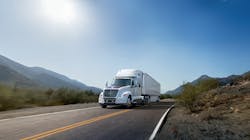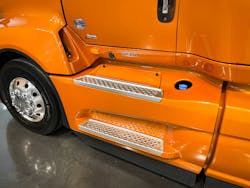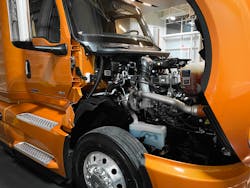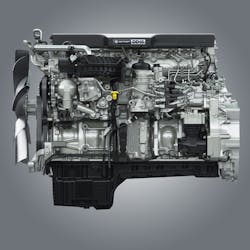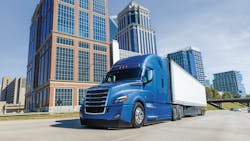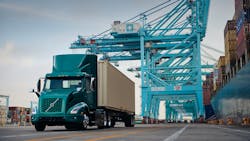Finding the efficiency sweet spot in trucking
Extended roof fairings and air deflectors, cab extenders to close the tractor-trailer gap, cab-to-skirt closeouts, tire pressure monitoring, trailer skirts—and the list goes on. These features can help on-highway trucks reduce aerodynamic drag and improve fuel economy, a major part of the total cost of ownership (TCO) equation for commercial carriers today.
Because TCO is truly the end goal for over-the-road trucking operations, both truck and trailer manufacturers continue to work out ways to help fleets reduce drag and parasitic losses on their equipment.
Uptime also is a major part of that efficiency equation. And as COVID-19-related supply chain constraints have shown us all, equipment trends that enhance capacity and productivity will never go out of style.
“Our customers’ North Star is always lowest total cost of ownership,” explained Mary Aufdemberg, general manager of product strategy and market development for Daimler Truck North America (DTNA). “This requires, among other things, maximum efficiency and uptime for owners and operators.”
For Chet Ciesielski, VP of Navistar’s on-highway truck business, TCO for his segment starts with fuel efficiency. To enhance fleet fuel economy efforts, Navistar has put a great deal of emphasis on adding aerodynamic devices and features to its International LT and RH Series on-highway tractors.“We really want to focus and work with the fleets,” Ciesielski told FleetOwner. “The fleets still have to have control of what they’re using and what their speed configurations are.”
In addition to fuel efficiency and uptime, major trucking OEMs also are seeing growing trends toward sustainability. Aside from companies investing in and adopting environmental, social, and corporate governance plans, federal greenhouse gas (GHG) emissions regulations for 2024 and 2027 are precipitating significant changes for diesel powertrain offerings.
See also: Cummins unveils fuel-agnostic internal combustion engineEmissions reduction, fuel efficiency
When considering future equipment trends and offerings, manufacturers are prioritizing what fleets are asking for while ensuring equipment complies with both current and incoming regulations.
“Everybody wants fuel economy, and everybody wants performance,” Navistar’s Ciesielski explained. “The regulatory compliance roadmap shows you that in the next six years, there are a lot of reductions coming in place that will drive electrification. Government is driving toward improved fuel, which helps the fleet, and it’s also driving us toward a more electrified future.”
Without question, however, even as the industry moves toward that electric future, the internal combustion engine will continue to play a leading role. And diesel will be around for many years to come.
“We have to make continuous improvements on those products because the fleets will be running those on a large scale for at least the next five to 10 years,” Ciesielski advised.
Navistar’s enhanced International A26 engine, for example, shows a fuel economy improvement of 4% to 5%. For the future, Navistar’s next-generation engine, expected for the 2023-2024 timeframe, Ciesielski said, will highlight even greater output improvements.DTNA has seen both a “push and pull demand,” where fleets are asking for newer technologies to achieve their own sustainability goals as it seeks to offer products with a continually diminishing carbon footprint, Aufdemberg pointed out. DTNA has plans to offer exclusively CO2-neutral vehicles (tank to wheel) in the U.S. market by 2039.
As part of that effort, DTNA continues to invest in its Detroit integrated powertrain and aerodynamics for the Freightliner Cascadia. Since its model introduction in 2007, the Cascadia’s fuel efficiency has improved nearly 35%, Aufdemberg explained. And when the Detroit DD15 Gen5 engine was introduced in 2020, it achieved more than 3% fuel economy improvement and allowed DTNA to exceed the federal GHG Phase II standards, she added.
“While I cannot speak to future product enhancements just yet, 2024 and 2027 emissions regulations are sure to precipitate big changes on diesel offerings, and DTNA is committed to improving diesel technology to benefit our customers and meet regulatory requirements,” Aufdemberg emphasized.Volvo Trucks North America (VTNA) is also working to drive the industry’s shift toward sustainability and zero emissions in transport.
Johan Agebrand, product marketing director at VTNA, said the company’s overarching target is to help minimize fleet customers’ environmental footprint as well as its own. Part of that strategy included Volvo’s decision in 2021 to make the Next Generation D13 Turbo Compound standard on all VNL sleeper models.
In the Volvo VNL 740, 760, and 860 models, the D13TC engine works to offer more fuel savings for a wider range of applications, such as long haul or local delivery, as well as fully or partially loaded. According to Volvo, the D13TC engine delivers improved fuel efficiency of up to 11% compared to 2015 Volvo truck models.
While Paccar’s Peterbilt is working to enhance fuel-efficiency improvements for fleet customers, the company is also focused on designs to make drivers more productive.
See also: Gallery: Tour the Paccar Innovation Center in Silicon ValleySome of those designs include enhanced visibility around the vehicle and the ease of getting in and out of the truck, Scott Newhouse, chief engineer for Peterbilt, toldFleetOwnerduring CES 2022 in Las Vegas in early January. “That is making an operator less tired and more productive behind the wheel,” Newhouse said. “We think productivity is efficiency, and some of those are key things in making fleets more efficient.”Paccar recently launched torque-overlay steering for Peterbilt and Kenworth trucks, Newhouse noted as another example of equipment efficiency trends. “It’s steering assistance that helps in backing maneuvering at slow speeds, which reduces additional stress on drivers,” he said.
Connectivity and uptime
While fuel economy and emissions reductions play key roles in overall equipment efficiency if a truck can’t make it from Point A to Point B uninterrupted, what’s the point? Today’s abundance of connected technologies aim to provide a holistic view of a vehicle’s health to improve equipment uptime.
Navistar, for example, offers its OnCommand Connection Advanced Remote Diagnostics solution, which provides fleets with real-time images and views of what’s going on with their assets. The goal is to help carriers better plan out their downtime and address any maintenance issues in advance of a down condition, Ciesielski said.
Another major piece of the uptime equation is ease of maintenance, he added.
“Our connected technology is the eyes to the vehicle for any fleet,” Ciesielski told FleetOwner. “We see what’s going on in the truck in real-time even before the driver sees it.”
Dealers and fleets can monitor the health of a vehicle in real-time via the International 360, Navistar’s fleet health monitoring system.
“This gives us the ability to give reports so they can [diagnose] on a weekly basis, a daily basis, whatever their cadence would want to be,” Ciesielski said. “It allows them to see the vehicle so they can keep it on the road and plan for anything that’s going on.”
The bigger lever moving forward, Ciesielski pointed out, is predictive fleet maintenance, which can flag a unit and predict when the vehicle should be taken off the road before a catastrophic or downtime event occurs.
DTNA also has its own connectivity solutions, Detroit Connect, which give fleets and dealers access to real-time vehicle performance data. “This allows fleet managers to make decisions about when the trucks need to be serviced, how to resolve fault codes, and optimize performance with remote updates to make parameter changes as well as ECU firmware updates,” Aufdemberg said.
Beyond vehicle insights, DTNA’s truck connectivity technologies also power efficient fleet management operations via in-depth reporting on safety events or by facilitating a digital platform ecosystem, she added.
DTNA recently partnered with Platform Science and its Virtual Vehicle platform so fleets could access telematics, software solutions, real-time vehicle data, and third-party applications directly from their vehicles.“It always goes back to some very key basics that you’re seeing,” Peterbilt’s Newhouse told FleetOwner. “Connectivity helps provide efficiency and how you manage it. Being more connected gives you more guidance.”
Newhouse said fleets can recognize those benefits in Paccar’s diagnostics solutions with over-the-air updates.
All of Volvo’s new trucks also come standard with remote diagnostics and remote software downloading. These solutions allow fleets to conduct necessary software updates or parameter setting changes remotely over the air instead of having to make an appointment at a dealership.
“Our customers are focused on making sure they have service plans tailored to their truck and business needs,” Agebrand noted. The Volvo Blue Contract plan, for example, delivers insights into service schedules and costs upfront, giving fleets service plans tailored to specific vehicles and applications.
In addition, remote diagnostics enable the Volvo Uptime Center to constantly monitor a truck's health, identifying when critical parts will reach their end of life, Agebrand added.
“Remote diagnostics help identify emerging issues before a breakdown occurs, which minimizes the occurrence of unplanned stops,” he said. “Remote programming enables over-the-air software updates in a matter of minutes to fix identified issues. This allows the truck to be constantly updated with the latest software, ensuring all components operate at their optimum efficiency, leading to better fuel efficiency, higher productivity, and uptime.”
Trailer efficiency and uptime
Like tractors, trailers also play a pivotal role when it comes to overall efficiency and fuel economy benefits in commercial trucking operations. And fleets, along with manufacturers, are focusing on smart trailer attributes to maximize uptime, which has become increasingly important during ongoing equipment shortages and build delays, explained Bill Hicks, product manager for SAF-Holland.
“By monitoring and communicating any operational issue before a trailer goes into service, the fleet manager can address any situation beforehand,” Hicks pointed out. “This allows for controlling service costs and scheduling as well as replacement part ordering in a timely and cost-effective manner.”
For customers of Stoughton Trailers, efficiency revolves around keeping trucks moving and hauling freight, explained Dave Giesen, VP of sales.
“What this means to them is having the necessary ready and empty trailers when they need them so drivers do not have to wait,” Giesen said. “They just need more trailers to do this.”
Giesen also noted that tracking and loaded/unloaded technology has a real impact on gaining efficiency. Several other new technologies will help with predicting trailer maintenance needs and monitoring the overall health of the asset.
The future of trailer efficiency likely will have skirts even more prevalent than today as they offer the biggest real fuel savings, Giesen pointed out. According to the North American Council for Freight Efficiency, trailer skirts are the most popular devices for addressing drag, offering 1% to more than 5% fuel savings versus trailers that don't have them onboard.
Late last year, however, trailers were removed from the latest GHG Phase II regulations after a panel of judges determined that because trailers have no motor and don’t use fuel, they don’t have to be governed under federal fuel requirements. However, fleets are continuing to adopt changes that will have an immediate ROI impact for their operations.
“Fleets will look at the cost of improvements and weigh against the actual gains they will see in reduced fuel consumption,” Giesen added. “This leads to good business decisions.”
Over time, federal regulatory agencies will mandate certain key attributes, such as temperature monitoring on refrigerated cargo, are monitored to ensure safety, product quality, and fuel efficiency, SAF-Holland’s Hicks noted.
Ultimately, when referring to smart trailers, Hicks said that the key functioning parameters of SAF-Holland’s products need to be “sensorized” and integrated into designs to provide the end user with actionable data.
The future roadmap
As the transportation industry works its way toward a zero-emission future, OEMs and fleets are discussing exactly what those paths look like and when newer technologies will become a scalable reality.
For Navistar, electric product offerings begin in the medium-duty and bus segments. Until battery-electric and hydrogen fuel cells are proven in the linehaul segment, Navistar is not expected to release a Class 8 electric truck, Mathias Carlbaum, Navistar president and CEO, said during a media roundtable discussion in February.
“About the timeframe of 2027 to 2028, we do see the real tipping point for long-haul technology, batteries, infrastructure, charging, and all of this comes together,” Carlbaum explained. “We will be gradually introducing it, but the real lever comes when the TCO case is so evident.”
Navistar’s Ciesielski told FleetOwner that the OEM’s future roadmap also includes autonomous truck technology over the next two decades. In the meantime, the on-highway plan, according to Ciesielski, is winning with aerodynamics and reducing parasitic losses.
“Trucking is the perfect environment to develop automated technologies, electrification technologies, and connected technology,” Stephan Olsen, Paccar Innovation Center general manager, told FleetOwner during CES 2022. “There's a business case where the tech pays the customer back over time. So, we see a lot of opportunities to excite the younger generation of talent to come into the trucking industry.”Volvo’s Agebrand also pointed to the next-generation Volvo VNR Electric and the OEM’s plans to introduce hydrogen fuel cell-powered trucks for long and heavy haul in the second half of the decade.
“As a transport provider, we are part of the problem, but we are very determined to be part of the solution and be a leader in sustainable transportation,” Volvo’s Agebrand said. “Decarbonization is what we need to achieve in our journey toward sustainability. The continued evolution of our trucks toward electrification is how.”
No matter what paths the industry takes along its journey to zero emissions, uptime and achieving the best possible TCO will remain king.
About the Author

Cristina Commendatore
Cristina Commendatore is a past FleetOwner editor-in-chief. She wrote for the publication from 2015 to 2023.
